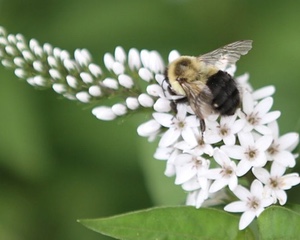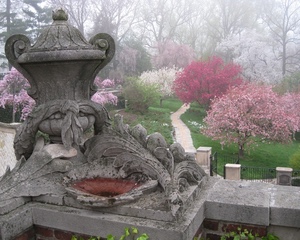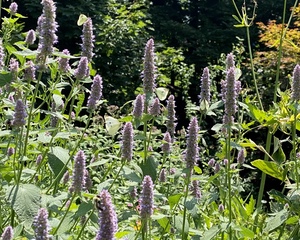

Health and Well-being
Benefits of Plants
By Charles Hall and Madeline W. Dickson
Sign up for our monthly newsletter!

Concentration and Memory
Being around plants helps people concentrate better in the home and workplace. Studies show that tasks performed while under the calming influence of nature are performed better and with greater accuracy, yielding a higher quality result. Moreover, being outside in a natural environment can improve memory performance and attention span by twenty percent.
Keeping ornamental plants in the home and in the workplace increases memory retention and concentration. The calming influence of natural environments is conducive to positive work environments by increasing a person’s ability to concentrate on the task at hand. Work performed under the natural influence of ornamental plants is normally of higher quality and completed with a much higher accuracy rate than work done in environments devoid of nature. Going outside or being under the influence of plants can increase memory retention up to twenty percent, a recent University of Michigan study showed. The effect of nature in the home and in the workplace serves to stimulate both the senses and the mind, improving mental cognition and performance.

Flowers Generate Happiness
Having flowers around the home and office greatly improves people’s moods and reduces the likelihood of stress-related depression. Flowers and ornamental plants increase levels of positive energy and help people feel secure and relaxed.
Keeping flowers around the home and in the workplace greatly reduces a person’s stress levels. Natural aesthetic beauty is soothing to people, and keeping ornamental flowers around the home environment is an excellent way to lower levels of stress and anxiety. People who keep flowers in their home feel happier, less stressed, and more relaxed. As a result of the positive energy they derive from the environment, the chances of suffering from stress-related depression are decreased as well. Overall, adding flowers to your home or work environment reduces your perceived stress levels and makes you feel more relaxed, secure, and happy. Flowers can help you achieve a more optimistic outlook on your life, bringing you both pleasing visual stimulation and helping you to increase your perceived happiness.

Health and Recreation
Access to parks and recreational activities is positively correlated with rates of physical activity, which improves mood and contributes to overall healthiness. Health care costs are subsequently reduced.
Parks and urban green spaces impact people’s health by providing them with an inexpensive (often free) and convenient recreational service. There is a positive correlation between the presence of a park in a neighborhood and the level of physical activity of the residents; people are much more likely to exercise when there is a no-cost, aesthetically pleasing area or facility for them to use. As a result, residents of neighborhoods with beautiful parks are much healthier; their increase in exercise makes them less susceptible to physical ailments and more resilient against minor illnesses. As a result, these residents do not spend as much each year on health care and medical treatment, because they require fewer of these services Healthy people are happier people; residents who exercise often have excellent overall health and therefore have a more positive mental outlook. The presence of parks in neighborhoods encourages residents to exercise, thus improving their physical state and enabling them to more fully enjoy their lives.

Accelerates Healing Process
The presence of plants in hospital recovery rooms and/or views of aesthetically-pleasing gardens help patients to heal faster, due to the soothing affects of ornamental horticulture.
Shrubs, trees, and flowers have a practical application in hospitals: the presence of plants in patient recovery rooms greatly reduces the time necessary to heal. The soothing effects of ornamental flowers and plants are so great that simply having daily views of flowers and other ornamental plants in landscaped areas outside patient recovery room significantly speed up recovery time. Another technique to decrease recovery time is horticulture therapy, where patients care for and nurture plants themselves. Patients who physically interact with plants experience a significantly reduced recovery time after medical procedures.

Improves Relationships/Compassion
Research shows that people who spend extended lengths of time around plants tend to have better relationships with others. This is due to measurable increases in feelings of compassion; another effect of exposure to ornamental plants.
Ornamental plants affect the levels of compassion that people feel for others. Studies have shown that people who spend more time around plants are much more likely to try and help others, and often have more advanced social relationships. People who care for nature are more likely to care for others, reaching out to their peers and forming shared bonds resulting from their common interests. Extended exposure to nature and wildlife increases people’s compassion for each other as it increases people’s compassion for the environment in which they live. In short, being around plants can help to improve relationships between people and increase their concern and empathy toward others.

Improved Human Performance/Energy
Spending time in natural environments makes people better at doing their jobs. It also increases energy levels and feelings of vitality.
Spending time in nature gives people an increased feeling of vitality, increasing their energy levels and making them feel more animated. Their performance levels are, in turn, increased by this improved state of mind. Natural environments induce a positive outlook on life, making people feel more alive and active. When people experience increased vigor, they put more of themselves and their energy into their work. Plants can help people to improve their performance at work and at home by increasing their perceived vitality and giving them more feelings of added energy.

Learning
Research shows that children who spend time around plants learn better. In addition, being around natural environments improves the ability of children with Attention Deficit Disorder to focus, concentrate, and engage more with their surrounding environment.
Keeping plants in a child’s learning environment enhances learning capabilities by helping them to focus and concentrate. This improves their ability to learn new things and makes it easier for them to absorb and retain information. Ornamental plants are conducive to generating a positive learning environment, reducing children’s tendency towards distraction and helping them to be better able concentrate on school work. Specifically for children with problems paying attention, adding plants to the classroom can have a dramatic positive effect on the way they learn. For example, children with Attention Deficit Disorder, learning in a natural environment can help them to engage more in the classroom, improving their focus and concentration on the task at hand. The soothing effects of natural aesthetic beauty help to minimize the distractions that would otherwise occupy their minds. By altering the environment in which children learn, plants can help them to learn better.

Medicinal Properties
Cultivating plants is beneficial to humankind because of the many medicinal properties of trees and foliage plants.
One of the more obvious benefits of plants and trees is that many of them have valuable medicinal properties. Cultivating plants helps humanity because it provides opportunities for additional scientific studies of the possible positive medicinal values of plants. Natural herbal remedies are simple and holistic methods for treating common illnesses and maladies. Some can be made in the home and are a natural way to treat minor complaints. By cultivating plants we can continue to cultivate our knowledge of the natural world and arm ourselves with more defenses against disease and infection.

Mental Health
Studies have proven that people who spend more time outside in nature have better mental health and a more positive outlook on life.
People who spend more time outside in nature have a significantly more positive outlook on life than people who spend a great deal of time indoors. Communing with the natural world increases people’s feelings of vitality and energy, and consequently has a large positive effect on their overall mental health. Being outside around trees and ornamental horticulture is proven to improve people’s mental health, and give them a more positive outlook on their lives. People who spend time outside every day are less likely to be depressed or stressed, and thus have fewer burdens on their mental health.

Perceived Quality of Life
People associate beautifully landscaped areas with a higher quality of life. This is important in attracting businesses and sustaining growth in the community.
Beautiful natural landscapes not only improve the aesthetics of the community, they also affect resident’s perceived quality of life. People associate living in areas with a great deal of natural beauty with a higher quality of life. A high quality of life, in turn, benefits the entire community, because residents spend more money and positively affect the economy and social pulse of the town and can also attract new businesses. Thriving communities are ones in which natural beauty is appreciated as a part of an overall high quality of life, which is why installing landscaping is crucial to both the success and happiness of the individual and the public.

Reduce Community Crime / Community Cohesion
Neighborhoods with beautiful parks tend to have less crime. This is due in part to the effect that parks have on a community; parks give people a reason to come together and become a tight-knit community. People who care about their neighborhood parks are much more likely to get politically involved when businesses threaten to downsize them. Increasing political activism in the community is another positive outcome of cultivating a love for neighborhood parks.
Neighborhoods with beautiful parks and landscaping have reduced crime rates. This is due to the increase in community cohesion that occurs as a neighborhood rallies around a beautiful local landmark. When residents feel greater pride in the beauty of where they live, they are much less likely to detract from it (either by graffiti or endangering people within it). Communities that choose to clean up their parks and beautify crime-ridden neighborhoods have less crime and fewer criminals to deal with. Parks can positively affect the community be reducing criminal acts and bringing residents together. Cohesion in the community is critical to the success of the community as a whole, and this can be achieved through unifying people around a park or botanical garden. Parks decrease incentives for people to commit crimes in the community, and at the same time help to bring neighbors together. They can also increase local political activism. As businesses and urban expansion threatens to downsize parks in the community, more and more people are banding together in a political effort to save their parks. Parks inspire people to come together and fight for what they know is holding them together as a community.

Reduce Stress
Studies show that people who spend time cultivating plants have less stress in their lives. Plants soothe human beings and provide a positive way for people to channel their stress into nurturing.
Participation in gardening and landscaping activities is an effective way to reduce levels of stress. Studies have shown that people who nurture plants and garden have less mental distress than others. Gardening provides people with a positive way to channel their stress and frustration into something beautiful that provides them with comfort and joy. Part of the effects of gardening come from the satisfaction people get from nurturing and helping a living thing grow. Plants and gardening soothe people because they help them turn their stressful feelings into something positive which gives them pleasure. By helping them transform their stress into a more positive emotion, gardening also gives people an excellent coping mechanism for their daily frustrations. Nurturing plants reduces stress levels and gives people a way to cope with their negative feelings.

Therapeutic Effects of Gardening
Gardening can act as therapy for people who have undergone trauma. The act of nurturing something is a way for people to work through the issues surrounding traumatic events and improve their mental health.
Gardening can have therapeutic effects on people who have undergone trauma, either mental or physical. The act of nurturing a plant can provide victims with a way to work through their issues and heal their wounds, whether they are on the surface of the skin or deeper. Cultivating plants also improves their mental states and helps to put them in a better place for recovering. Gardening is a therapeutic tool that can be used to help put people in a better psychological state during recovery and help them to work past the mental barriers that could impede their healing.

Traffic Safety / Driver Satisfaction
Beautifying road ways can have the dual effect of increasing driver satisfaction with the roadside landscape and creating a natural median. Drivers are much less likely to accidentally drive over a median if there is a landscaped area between oncoming lanes of traffic.
Beautifying traffic medians not only improves the aesthetics of the roadways, it also affects driver attitudes. Studies show that drivers are more at ease on roadways with natural landscaping, and are much more inclined to think positively about the community that they are driving through if the roadways are beautiful. Furthermore, adding trees to roadways creates a sort of natural obstruction which could reduce the likelihood of cars crossing medians into oncoming traffic lanes. This improves driver safety and makes the community a safer place for everyone to live in. Landscaped areas between oncoming lanes of traffic could decrease the number of accidents occurring due to drivers crossing the median and make the road a safer place.

Upgrade Effect
As parts of the community begin to improve their urban green spaces, other areas will be forced to stay competitive and beautify their areas as well. The upgrade effect benefits the entire community, as neighborhoods and businesses encourage each other to landscape and beautify the community.
As more businesses and neighborhoods take on the task of beautifying their surroundings, other competing areas will be forced to follow suit. In other words, as a community works to better itself, other parts of the area will be forced to upgrade as well to keep drawing people in; this phenomenon is known as the upgrade effect. The upgrade effect positively affects everyone, because it keeps communities from ignoring the benefits of landscaping and developing green spaces, it forces competition and keeps the area looking beautiful. Neighborhoods will be encouraging each other to keep beautifying the landscaping, setting off a cycle of self-improvement that has positive ripple effects outwards to all sectors of the community.
Charlie Hall, Ph.D. is a Professor and Ellison Chair in International Floriculture, Texas A & M. Madeline W. Dickson was a student worker at the Department of Horticultural Sciences Texas A&M University.
References:
1.
Brethour, C., G. Watson, B. Sparling, D. Bucknell, and T.-L. Moore. 2007. Literature review of documented health and environmental benefits derived from ornamental horticulture products. Agriculture and Agri-Food Canada Markets and Trade, Ottawa, ON.
Serwach, J.. 2008. Going outside—even in the cold—improves memory, attention. <http://www.ns.umich.edu/htdocs/releases/story.php?id=6892>.
Shibata, S., Suzuki, N 2004. Effects of an indoor plant on creative task performance and mood. Scandinavian journal of psychology. 10.1111/j.1467-9450.2004.00419
Werner. J.E.B., J. Raser, T.J. Chandler, and M. O’Gorman. 1996. A study of the economic impacts of trees and forests in the commercial districts of New York City and New Jersey. New York Street Tree Consortium, Inc.
Yannick J., Brengman M., Willems K. 2009. The effects of urban retail greenery on consumer experience. Reviewing the evidence from a restorative perspective. Urban Forestry and Urban Greening 9:57-64.
2.
Brethour, C., G. Watson, B. Sparling, D. Bucknell, and T.-L. Moore. 2007. Literature review of documented health and environmental benefits derived from ornamental horticulture products. Agriculture and Agri-Food Canada Markets and Trade, Ottawa, ON.
Collins, C.C. and A.M. O’Callaghan. 2008. The impact of horticultural responsibility on health indicators and quality of life in assisted living. HortTechnology 18:611–618.
Dunnett, N. and M. Qasim. 2000. Perceived benefits to human well-being of urban gardens. HortTechnology 10:40–45.
Haviland-Jones, J., Roseario, H. 2005. An Environmental Approach to Positive Emotion: Flowers, Evolutionary Psychology, 3:104-132
Raanaas, R.K., G.G. Patil, and T. Hartig. 2010. Effects of an indoor foliage plant intervention on patient well-being during a residential rehabilitation program. HortScience 45:387–392.
Rappe, E. (2005). The Influence of a Green Environment and Horticultural Activities on the Subjective Well-Being of the Elderly Living in Long-Term Care.
Haviland-Jones, J., H.H. Rosario, P. Wilson, and T.R. McGuire. 2005. An environmental approach to positive emotion: Flowers. Evolutionary Psychology 3:104–132.
Waliczek, T., Bradley, J.C., Lineberger, 2000. Using a Web-based survey to research the benefits of children gardening. American Society for Horticultural Science 10:1; 71-76
3.
Appleseed, Inc. 2009. Valuing Central Park’s contributions to New York City’s economy. http://www.appleseedinc.com/reports/centralpark- may2009.pdf. Accessed December 15, 2010.
Brethour, C., G. Watson, B. Sparling, D. Bucknell, and T.-L. Moore. 2007. Literature review of documented health and environmental benefits derived from ornamental horticulture products. Agriculture and Agri-Food Canada Markets and Trade, Ottawa, ON.
Fjeld, T. 2000. The effect of interior planting on health and discomfort among workers and school children. HortTechnology 10:46–52.
Mitchell, R. and F. Popham. 2008. Effect of exposure to natural environment on health inequalities: an observational population study. The Lancet 372 (9650):1655–1660.
Sallis, J.F., P.R. Nader, S.L. Broyles, C.C. Berry, J.P. Elder, T.L. Mckenzie, and J.A. Nelson. 1993. Correlates of physical-activity at home in mexican-american and anglo-american preschool-children. Health Psychol. 12:390–398.
The Trust for Public Land. 2008. https://www.tpl.org/.
Werner. J.E.B., J. Raser, T.J. Chandler, and M. O’Gorman. 1996. A study of the economic impacts of trees and forests in the commercial districts of New York City and New Jersey. New York Street Tree Consortium, Inc.
Wolf, K.L. 2004. Nature in the retail environment: Comparing consumer and business response to urban forest conditions. Landscape J. 23:40–51.
4.
Brethour, C., G. Watson, B. Sparling, D. Bucknell, and T.-L. Moore. 2007. Literature review of documented health and environmental benefits derived from ornamental horticulture products. Agriculture and Agri-Food Canada Markets and Trade, Ottawa, ON.
Lohr, Virginia I., Caroline H. Pearson-Mims. 2000. Physical Discomfort May Be Reduced in the Presence of Interior Plants. HortTechnology Vol. 10 Issue 1: 53-58.
Park, S. and R.H. Mattson. 2009. Ornamental indoor plants in hospital rooms enhanced health outcomes of patients recovering from surgery. J. Alternative & Complementary Medicine 15:975–980.
Pennsylvania Landscape and Nursery Association. 2009. https://www.plna.com/.
Ulrich, R.S. View Through a Window May Influence Recovery From Surgery. April 27, 1984. Science 27, Issue 4647: 420-421. https://science.sciencemag.org/content/224/4647/420.abstract.
5.
Brethour, C., G. Watson, B. Sparling, D. Bucknell, and T.-L. Moore. 2007. Literature review of documented health and environmental benefits derived from ornamental horticulture products. Agriculture and Agri-Food Canada Markets and Trade, Ottawa, ON.
Haviland-Jones, J., H.H. Rosario, P. Wilson, and T.R. McGuire. 2005. An environmental approach to positive emotion: Flowers. Evolutionary Psychology 3:104–132.
Rappe, Erja. The Influence of a Green Environment and Horticultural Activities on the Subjective Well-Being of the Elderly Living in Long-Term Care. May 2005. University of Helsinki Department of Applied Biology No. 24. https://helda.helsinki.fi/bitstream/handle/10138/20703/theinflu.pdf;sequence=1.
6.
Brethour, C., G. Watson, B. Sparling, D. Bucknell, and T.-L. Moore. 2007. Literature review of documented health and environmental benefits derived from ornamental horticulture products. Agriculture and Agri-Food Canada Markets and Trade, Ottawa, ON.
Bringslimark, T., T. Hartig, and G.G. Patil. 2007. Psychological benefits of indoor plants in workplaces: Putting experimental results into context. HortScience 42:581–587.
Dravigne, A., T.M. Waliczek, R.D. Lineberger, and J.M. Zajicek. 2008. The effect of live plants and window views of green spaces on employee perceptions of job satisfaction. HortScience 43:183–187.
Kaplan, S.1995. The restorative benefits of nature: Toward an integrative framework. Journal of Environmental Psychology, 15; 3:169-182
Kuo, F.E. and W.C. Sullivan. 2001. Environment and crime in the inner city — does vegetation reduce crime? Environment and Behavior 33:343–367.
Shoemaker, C.A., K. Randall, P.D. Relf, and E.S. Geller. 1992. Relationships between plants, behavior, and attitudes in an office environment. HortTechnology 2:205–206.
7.
Faber Taylor, Andrea. 2001. Coping with ADD: The Surprising Connection to Green Play Settings. Environment and Behavior Vol. 33 Issue 1. https://journals.sagepub.com/doi/abs/10.1177/00139160121972864.
Kellert, Stephen R. 2002. “Experiencing Nature: Affective, Cognitive, and Evaluative Development in Children.” Children and Nature. MIT Press.
Kuo, F.E. 2004. Horticulture, well-being, and mental health: From intuitions to evidence. Expanding Roles for Horticulture in Improving Human Well-Being and Life Quality, p. 27–34.
Kuo, F.E. and A.F. Taylor. 2004. A potential natural treatment for attention-deficit/hyperactivity disorder: Evidence from a national study. Am. J. Public Health 94:1580–1586.
Lieberman, Gerald A, Linda L. Hoody. 1998. Closing the Achievement Gap: Using the Environment as an Integrating Context for Learning. Results of a Nationwide Study. https://files.eric.ed.gov/fulltext/ED428943.pdf.
Sullivan, W.C., F.E. Kuo, and S.F. DePooter. 2004. The fruit of urban nature — vital neighborhood spaces. Environment and Behavior 36:678–700.
8.
Brethour, C., G. Watson, B. Sparling, D. Bucknell, and T.-L. Moore. 2007. Literature review of documented health and environmental benefits derived from ornamental horticulture products. Agriculture and Agri-Food Canada Markets and Trade, Ottawa, ON.
9.
Barnicle, Tom and Karen Stoelzle Midden. 2003. The Effects of a Horticulture Activity program on the Psychological Well-being of Older People in a Long-term Care Facility. HortTechnology Vol. 13 Issue 1: 81-85. https://journals.ashs.org/horttech/view/journals/horttech/13/1/article-p81.xml.
Grinde, B. and G.G. Patil. 2009. Biophilia: Does visual contact with nature impact on health and well-being? Internat. J. Env. Res. Pub. He. 6:2332–2343.
Faber Taylor, Andrea. 2001. Coping with ADD: The Surprising Connection to Green Play Settings. Environment and Behavior Vol. 33 Issue 1. https://journals.sagepub.com/doi/abs/10.1177/00139160121972864.
Morikami Museum and Japanese Gardens. 2009. https://morikami.org/.
Wolf, K.L. 2004. Nature in the retail environment: Comparing consumer and business response to urban forest conditions. Landscape J. 23:40–51.
10.
Brethour, C., G. Watson, B. Sparling, D. Bucknell, and T.-L. Moore. 2007. Literature review of documented health and environmental benefits derived from ornamental horticulture products. Agriculture and Agri-Food Canada Markets and Trade, Ottawa, ON.
Nadel, Rebecca Ellen. 2005. Economic Impacts of Parks, Rivers, Trails and Greenways. School of Natural Resources and Environment at the University of Michigan. http://www.wildonesniagara.com/images/Nadel-2.pdf.
Phipps Botanical Gardens and Conservatory. 2010. https://www.phipps.conservatory.org/.
Werner. J.E.B., J. Raser, T.J. Chandler, and M. O’Gorman. 1996. A study of the economic impacts of trees and forests in the commercial districts of New York City and New Jersey. New York Street Tree Consortium, Inc.
Wolf, K.L. 2004. Nature in the retail environment: Comparing consumer and business response to urban forest conditions. Landscape J. 23:40–51.
Younis, A., M. Qasim, and A. Riaz. 2008. Case study: Impact of a well-planned landscape in delivering quality of life to city dwellers. Acta Hortic:147–154.
11.
Appleseed, Inc. 2009. Valuing Central Park’s contributions to New York City’s economy. http://www.appleseedinc.com/reports/centralpark- may2009.pdf. Accessed December 15, 2010.
Brethour, C., G. Watson, B. Sparling, D. Bucknell, and T.-L. Moore. 2007. Literature review of documented health and environmental benefits derived from ornamental horticulture products. Agriculture and Agri-Food Canada Markets and Trade, Ottawa, ON.
Gorham, M.R., T.M. Waliczek, A. Snelgrove, and J.M. Zajicek. 2009. The impact of community gardens on numbers of property crimes in urban Houston. HortTechnology 19:291–296.
Inerfield RB , Blom BB A new tool for strengthening urban neighbourhoods . Journal of Affordable Housing 2002; 11: 128-134
Kuo, F.E., W.C. Sullivan, R.L. Coley, and L. Brunson. 1998. Fertile ground for community: Inner-city neighborhood common spaces. American Journal of Community Psychology 26:823–851.
Kuo, F.E. and W.C. Sullivan. 2001. Environment and crime in the inner city — does vegetation reduce crime? Environment and Behavior 33:343–367.
Kuo, F.E. 2003. The role of arboriculture in a healthy social ecology. J. Aboriculture 29:148–155.
Pennsylvania Landscape and Nursery Association. 2009. https://www.plna.com/.
Ryan, R.M., N. Weinstein, J. Bernstein, K.W. Brown, L. Mistretta, and M. Gagne. 2010. Vitalizing effects of being outdoors and in nature. J. Environ. Psychology 30:159–168.
Taylor, A.F., F.E. Kuo, and W.C. Sullivan. 2001. Coping with ADD — the surprising connection to green play settings. Environment and Behavior 33:54–77.
The Trust for Public Land. 2008. https://www.tpl.org/.
Werner. J.E.B., J. Raser, T.J. Chandler, and M. O’Gorman. 1996. A study of the economic impacts of trees and forests in the commercial districts of New York City and New Jersey. New York Street Tree Consortium, Inc.
Wolf, K.L. 2004. Nature in the retail environment: Comparing consumer and business response to urban forest conditions. Landscape J. 23:40–51.
12.
Brethour, C., G. Watson, B. Sparling, D. Bucknell, and T.-L. Moore. 2007. Literature review of documented health and environmental benefits derived from ornamental horticulture products. Agriculture and Agri-Food Canada Markets and Trade, Ottawa, ON.
Bringslimark, T., T. Hartig, and G.G. Patil. 2007. Psychological benefits of indoor plants in workplaces: Putting experimental results into context. HortScience 42:581–587.
Kohlleppel, T., J.C. Bradley, and S. Jacob. 2002. A walk through the garden: Can a visit to a botanic garden reduce stress? HortTechnology 12:489–492.
Mitchell, R. and F. Popham. 2008. Effect of exposure to natural environment on health inequalities: an observational population study. The Lancet 372 (9650):1655–1660.
Ulrich, R.S., R.F. Simons, B.D. Losito, E. Fiorito, M.A. Miles, and M. Zelson. 1991. Stress recovery during exposure to natural and urban environments. J. Environ. Psychology 11:201–230.
Waliczek, T.M., R.D. Lineberger, J.M. Zajicek, and J.C. Bradley. 2000. Using a web-based survey to research the benefits of children gardening. HortTechnology 10:71–76.
13.
Aldous, D.E. 2000. Perspectives on horticultural therapy in australia. HortTechnology 10:18–23.
Barnicle, Tom and Karen Stoelzle Midden. 2003. The Effects of a Horticulture Activity program on the Psychological Well-being of Older People in a Long-term Care Facility. HortTechnology Vol. 13 Issue 1: 81-85. https://journals.ashs.org/horttech/view/journals/horttech/13/1/article-p81.xml.
Brethour, C., G. Watson, B. Sparling, D. Bucknell, and T.-L. Moore. 2007. Literature review of documented health and environmental benefits derived from ornamental horticulture products. Agriculture and Agri-Food Canada Markets and Trade, Ottawa, ON.
Collins, C.C. and A.M. O’Callaghan. 2008. The impact of horticultural responsibility on health indicators and quality of life in assisted living. HortTechnology 18:611–618.
Morikami Museum and Japanese Gardens. 2009. https://morikami.org/.
Rappe, Erja. The Influence of a Green Environment and Horticultural Activities on the Subjective Well-Being of the Elderly Living in Long-Term Care. May 2005. University of Helsinki Department of Applied Biology No. 24. https://helda.helsinki.fi/bitstream/handle/10138/20703/theinflu.pdf;sequence=1.
Stoneham, J.A., A.D. Kenle, and P.R. Thoday. 1995. Horticultural therapy: Horticulture’s contribution to the quality of life of disabled people. p. 65–75. Horticulture in Human Life, Culture, and Environment.
14.
Wolf, K.L. 2006. Assessing Public Response to Freeway Roadsides: Urban Forestry and Context-Sensitive Solutions. The Transportation Research Record: Journal of the Transportation Research Board. https://journals.sagepub.com/doi/abs/10.1177/0361198106198400110.
15.
Brethour, C., G. Watson, B. Sparling, D. Bucknell, and T.-L. Moore. 2007. Literature review of documented health and environmental benefits derived from ornamental horticulture products. Agriculture and Agri-Food Canada Markets and Trade, Ottawa, ON.
Werner. J.E.B., J. Raser, T.J. Chandler, and M. O’Gorman. 1996. A study of the economic impacts of trees and forests in the commercial districts of New York City and New Jersey. New York Street Tree Consortium, Inc.

As Ireland transitions from the rich, smoky scent of peat-burning to a more sustainable future, its olfactory heritage is evolving. What will become the next iconic aromatic symbol of Ireland?
Click to watch the documentary trailer.






